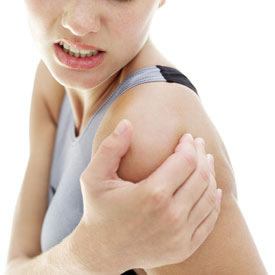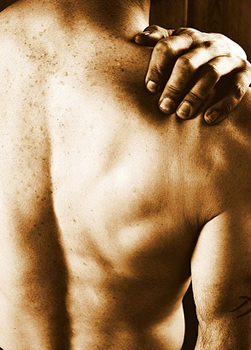
health
Recovery from Muscle Soreness
 Muscle soreness should be part of every exercise program. If you don't exercise intensely enough on one day to have sore muscles on the next, you will not gain maximum fitness and you are also losing out on many of the health benefits of exercise. The benefits of exercise are much greater with intense exercise than with casual exercising.
Muscle soreness should be part of every exercise program. If you don't exercise intensely enough on one day to have sore muscles on the next, you will not gain maximum fitness and you are also losing out on many of the health benefits of exercise. The benefits of exercise are much greater with intense exercise than with casual exercising.
You must damage your muscles to make them grow and become stronger. When muscles heal, they are stronger than they were before you damaged them. All athletes train by "stressing and recovering." On one day, they take a hard workout in which they feel their muscles burning. Eight to 24 hours after they finish this intense exercise, their muscles start to feel sore. This is called Delayed Onset Muscle Soreness (DOMS). Then they take easy workouts until the soreness is gone, which means that their muscles have healed.
DOMS IS CAUSED BY MUSCLE DAMAGE. Muscles are made up of fibers. The fibers are made up of a series of protein blocks called sarcomeres that are lined in a long chain. When you stretch a muscle, you stretch apart the sarcomeres in the chain. When sarcomeres are stretched too far, they tear. Your body treats these tears in the same way that it treats all injuries, by a process called inflammation. Eight to 24 hours after an intense workout, you suffer swelling, stiffness and pain. The most beneficial intense exercise program is:
• severe enough to cause muscle pain on the next day, and
• usually allows you to recover almost completely within 48 hours.
ACTIVE, NOT PASSIVE, RECOVERY: When athletes feel soreness in their muscles, they rarely take days off. Neither should you. Keeping sore muscles moving makes them more fibrous and tougher when they heal, so you can withstand greater forces and more intense workouts on your hard days. Plan to go at low intensity for as many days as it takes for the soreness to go away. Most athletes try to work out just hard enough so that they recover and are ready for their next hard workout in 48 hours.
TIMING MEALS TO RECOVER FASTER: You do not need to load extra food to recover faster. Taking in too much food fills your muscle cells with fat, and extra fat in cells blocks the cell's ability to take in and use sugar. Sugar is the main source of energy for your muscles during intense exercise. Using sugar to drive your muscles helps them to move faster and with more strength.
Timing of meals is more important than how much food you eat. Eating protein- and carbohydrate-containing foods helps you recover faster, and the best time to start eating is as soon as you finish a hard workout.
At rest, muscles are inactive. Almost no sugar enters the resting muscle cell from the bloodstream (J. Clin. Invest. 1971; 50: 2715-2725). Almost all cells in your body usually require insulin to drive sugar into their cells. However during exercise your muscles (and your brain) can take sugar into their cells without needing insulin. Exercising muscles are also incredibly sensitive to insulin and take up sugar into their cells at a rapid rate. This effect lasts maximally for up to an hour after you finish exercising and disappears almost completely in around 17 hours. The best time to eat for recovery is when your cells are maximally responsive to insulin, and that is within a short time after you finish exercising.
Not only does insulin drive sugar into muscle cells, it also drives in protein building blocks, called amino acids. The sugar replaces the fuel for muscle cells. The protein hastens repair of damaged muscle. Waiting to eat for more than an hour after finishing an intense workout delays recovery.
WHAT TO EAT AFTER YOUR INTENSE WORKOUTS: Fatigue is caused by low levels of sugar, protein, water and salt. You can replace all of these with ordinary foods and drinks. If you are a vegetarian, you can replace your protein with combinations of grains and beans. You can replace carbohydrates by eating virtually any fruits, vegetables, whole grains, beans, seeds and nuts.
A recovery meal for a vegetarian could include corn, beans, water, bread, and fruits, nuts and vegetables. If you prefer animal tissue,  you can get your protein from fish, poultry or meat. Special sports drinks and sports supplements are made from ordinary foods and therefore offer no advantage whatever over regular foods.
you can get your protein from fish, poultry or meat. Special sports drinks and sports supplements are made from ordinary foods and therefore offer no advantage whatever over regular foods.
BODY MASSAGE: Many older studies have shown that massage does not help you recover faster from DOMS. Recently, researchers at McMaster University in Hamilton, Ontario showed that deep massage after an intense workout causes muscles to enlarge and grow new mitochondria (Science Translational Medicine, published online Feb, 2012). This is amazing. Enlarging and adding mitochondriacan help you run faster, lift heavier weights, and even prevent heart attacks and certain cancers. See article here.
NSAIDS DELAY DOMS RECOVERY: Non-steroidal anti-inflammatory drugs (NSAIDS), such as ibuprofen, mayhelp relieve pain, but they also canblock muscle repair and delay healing. See article here.
HOT BATHS: Most research shows that a hot bath is not much better than doing nothing in helping muscles recover from exercise (European Journal of Applied
Physiology, March 2006),
COLD OR ICE BATHS: A recent review of 17 small trials, involving 366 participants, showed a minor decrease in DOMS with ice water baths. They found "little quality research" on the subject and "no consistent method of cold water immersion" (Cochrane Library, published online February 15, 2012). Cold water immersion can reduce swelling associated with injury, but has not been proven to speed the healing of DOMS.
Sports medicine doctor, fitness guru and long-time radio host Gabe Mirkin, M.D., provides news and tips for your healthful lifestyle. Get more information at his website, DrMirkin.com.
© 2006-2013 ConceptDesign, Inc. Terms of Use
BoomSpeak - For babyboomers - by babyboomers.